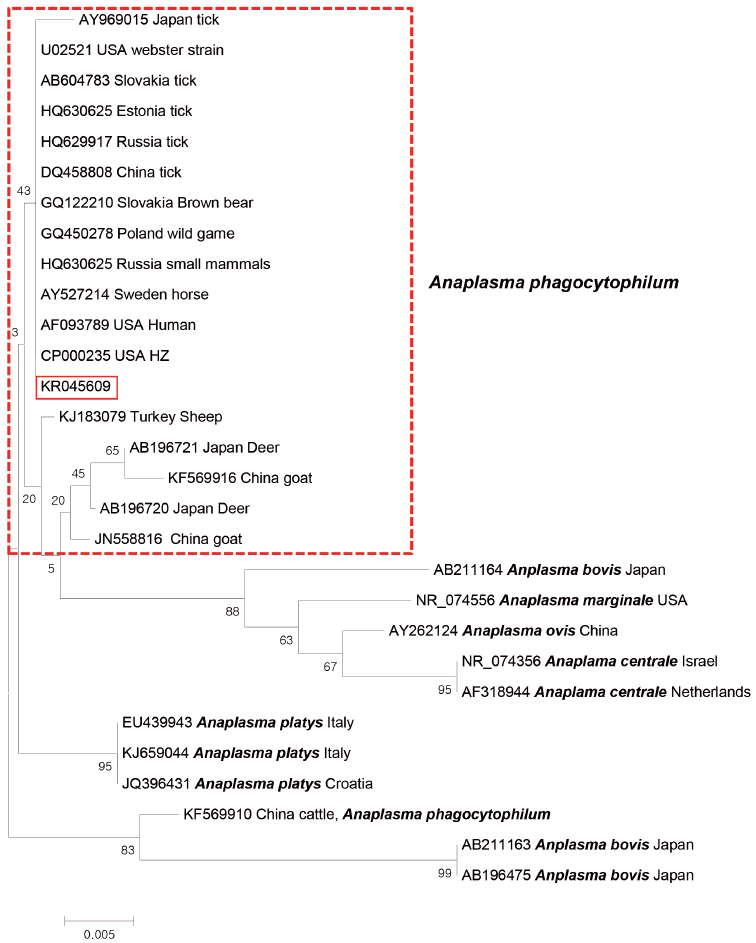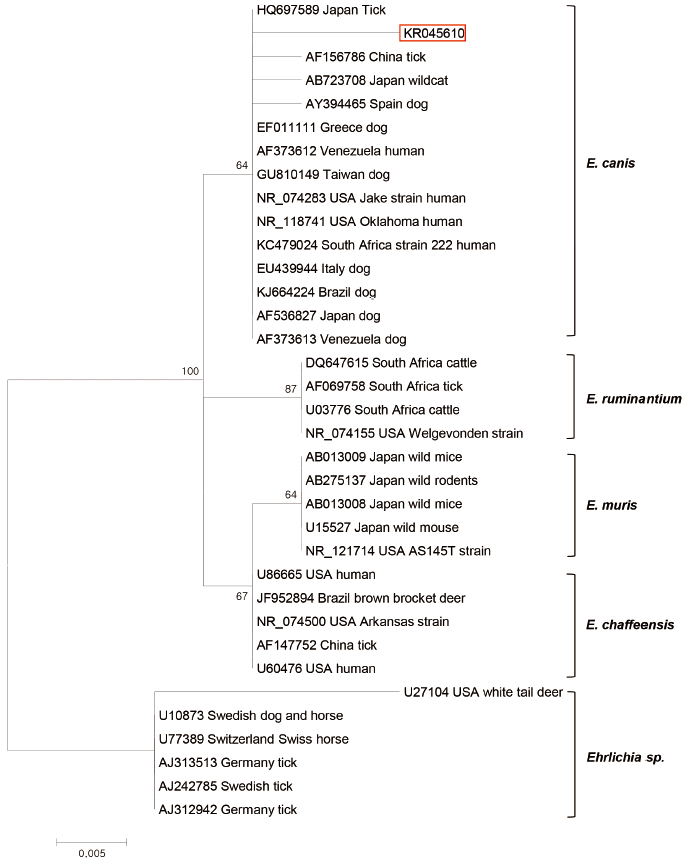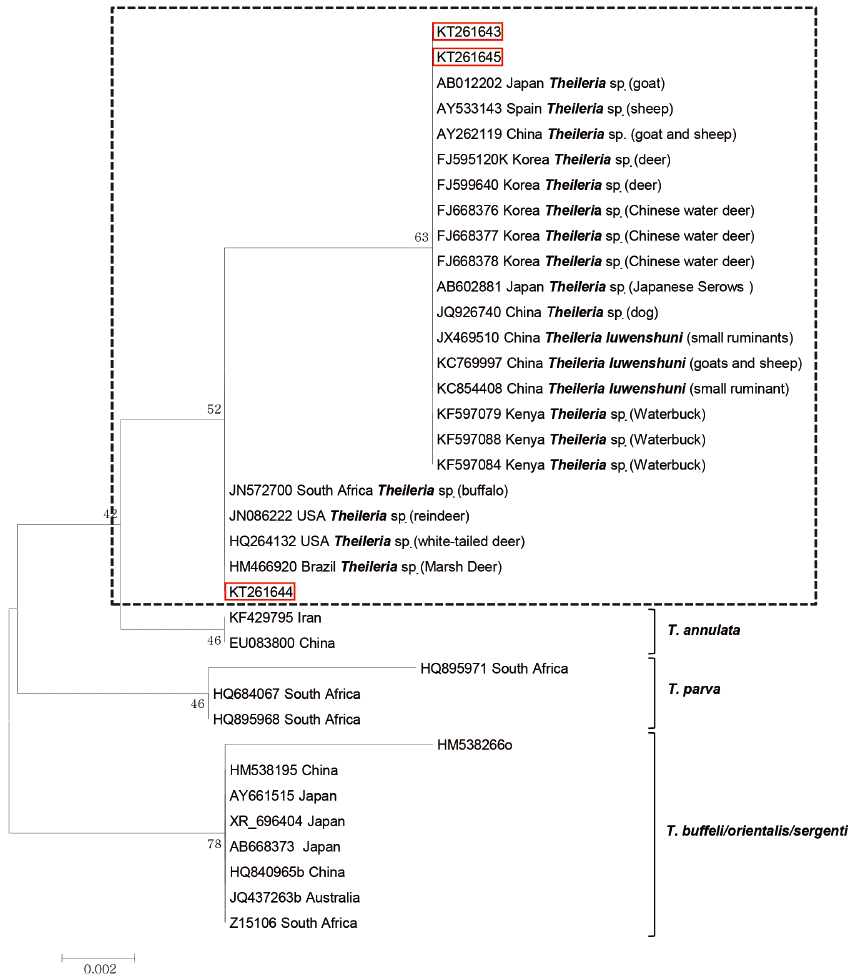Cited By
Citations to this article as recorded by

Exploring the relationship between flumethrin resistance and Anaplasma marginale infection in Rhipicephalus (Boophilus) microplus ticks of cattle
Meghavi Vasantbhai Patel, Niranjan Kumar, Jayesh Babulal Solanki, Irsadullakhan Habibullakhan Kalyani, Dharmeshkumar Chandrakantbhai Patel, Dharmeshkumar Babubhai Bhinsara
Tropical Animal Health and Production.2024;[Epub]
CrossRef First report of Anaplasma phagocytophilum infection in Holstein cattle in the Republic of Korea
Du-Gyeong Han, Ji-Hyoung Ryu, Jeong-Byoung Chae, Dong-Woo Kim, Chan-Ho Kwon, Kyoung-Seong Choi
Molecular detection of Rickettsia raoultii, Rickettsia tamurae, and associated pathogens from ticks parasitizing water deer (Hydropotes inermis argyropus) in South Korea
Min-Goo Seo, Oh-Deog Kwon, Dongmi Kwak
Ticks and Tick-borne Diseases.2021; 12(4): 101712.
CrossRef Genetic characterization and phylogenetic of Anaplasma capra in Persian onagers (Equus hemionus onager)
Hamid Staji, Mohammadhasan Yousefi, Mahmoud Ahmadi Hamedani, Iradj Ashrafi Tamai, Sahar Ghaffari Khaligh
Veterinary Microbiology.2021; 261: 109199.
CrossRef Molecular identification of selected tick-borne pathogens in wild deer and raccoon dogs from the Republic of Korea
Yu-Jung Han, Jinho Park, Young-Sung Lee, Joon-seok Chae, Do-Hyeon Yu, Bae-Keun Park, Hyeon-Cheol Kim, Kyoung-Seong Choi
Veterinary Parasitology: Regional Studies and Reports.2017; 7: 25.
CrossRef Identification of Zoonotic Tick-Borne Pathogens from Korean Water Deer (Hydropotes inermis argyropus)
Seung-Uk Shin, Yu-Jin Park, Ji-Hyoung Ryu, Dong-Hun Jang, Sunwoo Hwang, Hyung-Chul Cho, Jinho Park, Jae-Ik Han, Kyoung-Seong Choi
Vector-Borne and Zoonotic Diseases.2020; 20(10): 745.
CrossRef Surveillance and Molecular Identification ofBorreliaSpecies in Ticks Collected at U.S. Army Garrison Humphreys, Republic of Korea, 2018–2019
Seung-Ho Lee, Sung-Tae Chong, Heung-Chul Kim, Terry A Klein, Kyungmin Park, Jingyeong Lee, Jeong-Ah Kim, Won-Keun Kim, Jin-Won Song, Sarah Hamer
Journal of Medical Entomology.2022; 59(1): 363.
CrossRef Evaluation of the efficacy of ivermectin against Theileria orientalis infection in grazing cattle
Jinho Park, Jeong-Byoung Chae, Suhee Kim, Do-Hyeon Yu, Hyeon-Cheol Kim, Bae-Keun Park, Joon-Seok Chae, Kyoung-Seong Choi
BMC Veterinary Research.2019;[Epub]
CrossRef Molecular detection of Anaplasma bovis in Holstein cattle in the Republic of Korea
Jinho Park, Du-Gyeong Han, Ji-Hyoung Ryu, Jeong-Byoung Chae, Joon-Seok Chae, Do-Hyeon Yu, Bae-Keun Park, Hyeon-Cheol Kim, Kyoung-Seong Choi
Acta Veterinaria Scandinavica.2018;[Epub]
CrossRef Novel variants of the newly emerged Anaplasma capra from Korean water deer (Hydropotes inermis argyropus) in South Korea
Said Amer, Sungryong Kim, YoungMin Yun, Ki-Jeong Na
Parasites & Vectors.2019;[Epub]
CrossRef Molecular detection and phylogenetic analysis of tick-borne pathogens in wild Korean water deer and farmed elk in Gyeongbuk and Gangwon Provinces of Korea
Minkyo LEE, Min-Goo SEO, Seung-Hun LEE, In-Ohk OUH, Young-Hoan KIM, Joong-Kew KIM, Youn-Kyoung GOO, Man-Hee RHEE, Tae-Hwan KIM, Oh-Deog KWON, Dongmi KWAK
Journal of Veterinary Medical Science.2018; 80(9): 1473.
CrossRef Nationwide Geographical and Temporal Distribution of Tick-Borne Diseases in Korean Water Deer (Hydropotes inermis argyropus)
Beoul Kim, Su-Jin Chae, You-Jeong Lee, Haksub Shin, Sunmin Kwak, Hyesung Jeong, Suwoong Lee, Dongmi Kwak, Min-Goo Seo
Molecular Detection and Genotyping of Theileria spp. in Deer (Cervidae) in Korea
Chang Uk Chung, Haeseung Lee, Min-Goo Seo, Seung-Hun Lee, Kyoo-Tae Kim, Kaifa Nazim, Jung-Sun Song, Dong Hwa Bae, Man Hee Rhee, Oh-Deog Kwon, Dongmi Kwak
Microorganisms.2023; 11(11): 2740.
CrossRef Molecular Identification of Borrelia afzelii from Ticks Parasitizing Domestic and Wild Animals in South Korea
Min-Goo Seo, Oh-Deog Kwon, Dongmi Kwak
Microorganisms.2020; 8(5): 649.
CrossRef
Abstract
The objective of this study was to investigate the prevalence of tick-borne pathogens in the Korean water deer (Hydropotes inermis argyropus). Pathogens were identified using PCR which included Anaplasma, Ehrlichia, Rickettsia, and Theileria. Rickettsia was not detected, whereas Anaplasma, Ehrlichia, and Theileria infections were detected in 4, 2, and 8 animals, respectively. The most prevalent pathogen was Theileria. Of the 8 Theileria-positive animals, 2 were mixed-infected with 3 pathogens (Anaplasma, Ehrlichia, and Theileria) and another 2 animals showed mixed-infection with 2 pathogens (Anaplasma and Theileria). Sequencing analysis was used to verify the PCR results. The pathogens found in this study were identified as Anaplasma phagocytophilum, Ehrlichia canis, and Theileria sp. To the best of our knowledge, this is the first report identifying these 3 pathogens in the Korean water deer. Our results suggest that the Korean water deer may serve as a major reservoir for these tick-borne pathogens, leading to spread of tick-borne diseases to domestic animals, livestock, and humans. Further studies are needed to investigate their roles in this respect.
Key words: Anaplasma, Ehrlichia, Theileria, tick-borne pathogen, Korean water deer, reservoir
Tick infestations in animals are of increasing concern, mainly because the epidemiology and geographical distribution of these infestations are constantly changing due to climate change, abundance of wildlife animals as hosts, and decrease in environmental biodiversity [
1]. As a result, the incidence of tick-borne diseases (TBDs) has increased [
2]. Anaplasmosis and theileriosis, considered to be the most important TBDs, have resulted in animal health problems and extensive economic losses causing management-related problems in the livestock industry [
3,
4]. However, there have been relatively few studies on tick-borne pathogens from wild ungulates in Korea [
5-
7], and therefore, little information is available on how infections caused by these pathogens might affect the population.
Korean water deer (
Hydropotes inermis argyropus) are one of the most widely distributed wild ungulates in Korea, and are known to be important natural reservoir hosts of TBDs [
5,
6]. The Korean water deer has been classified as a vulnerable species and included in the International Union for Conservation of Nature and Natural Resources Red List, due to a serious decline in their population as a result of poaching and habitat destruction [
8]. Recently, however, wild Korean water deer populations have been growing in Korea [
9], and because of their close proximity to domestic animals, they may act as a disease transmission of tick-borne pathogens to these animals. Therefore, the objective of this study was to investigate the pathogens of TBDs in Korean water deer and to evaluate their roles as potential reservoirs for TBDs circulating in Korea.
The capture of wild Korean water deer and sample collection were performed with permission from the Wildlife Rescue Center located in the Jeonbuk Province, Korea. Between March and June 2014, 5 animals were captured and whole blood samples were collected. Five more animals were killed in the traffic accidents, found dead and transferred to the Wildlife Rescue Center by local residents, and their spleens were collected. No ticks were found in the first 5 animals. The blood samples and spleens were immediately frozen at -80˚C until DNA extraction was performed.
Genomic DNA was extracted from whole blood and spleen samples using a DNeasy Blood and Tissue Kit (Qiagen, Valencia, California, USA) according to the manufacturer’s instructions. Diagnosis of Theileria infection was performed using an AccuPower® Theileria PCR kit (Bioneer, Daejeon, Korea) using 2 specific primer sets targeting the 18S ribosomal RNA (F, 5´-GTTATAAATCGCAAGGAAGTTTAAGGC-3´; R, 5´-GTGTACAAAGGGCAGGGACGTA-3´). The predicted size of the amplified PCR product was 239 bp under the following cycling conditions: 94˚C for 5 min, followed by 40 cycles of 94˚C for 20 sec and 65˚C for 35 sec, and a final extension of 72˚C for 5 min. AccuPower® Rickettsiales 3-Plex PCR kit (Bioneer) was used to detect Anaplasma (F, 5´- TACCTCTGTGTTGTAGCTAACGC-3´; R, 5´-CTTGCGACATTGCAACCTATTGT-3´), Ehrlichia (F, 5´-CGGAATTCCTAGTGTAGAGG-3´; R, 5´-AGGAGGGATACGACCTTC AT-3´), and Rickettsia (F, 5´-TAGGGGATGATGGAATTCCTA-3´; R, 5´-CCCCCGTCA ATTCCTTTGAG-3´). These PCRs were performed using specific primer sets that targeted the 16S ribosomal RNA. The predicted sizes of the amplified PCR products for Anaplasma, Ehrlichia, and Rickettsia were 429 bp, 340 bp, and 252 bp, respectively, under the following cycling conditions: 95˚C for 15 min, followed by 40 cycles of 95˚C for 10 sec, 58˚C for 30 sec, and 72˚C for 30 sec, and then a final extension of 72˚C for 5 min. PCR products were separated by gel electrophoresis on 1.5% agarose gels and visualized by staining with ethidium bromide.
The PCR products were purified with a QIAquick PCR purification kit (Qiagen). The nucleotide sequences were determined by direct sequencing of the PCR products using a BigDye terminator cycle sequencing kit (Applied Biosystems, Foster City, California, USA) and analyzed on an ABI PRISM
® DNA analyzer (Applied Biosystems). The sequence data were aligned using the Clustal X (version 1.8) [
10]. Additional sequences from representative isolates of anaplasmosis, ehrlichiosis, and theileriosis were obtained from the GenBank database and included with each set of alignments. A phylogenetic tree based on nucleotide alignments was constructed using the neighbor-joining method [
11]. Bootstrap analysis was carried out using 1,000 replications, and the tree was visualized using Treeview [
12].
The prevalence of TBD pathogens was analyzed from blood and spleen samples of 10 Korean water deer by PCR (
Table 1). Of the 10 animals, 4 were positive for
Anaplasma infection, and 2 were positive for
Ehrlichia infection, and 8 were positive for
Theileria infection. Also, of these animals, 2 were found to have mixed-infections with 2 pathogens (
Anaplasma and
Theileria, n=2) and another 2 animals were found to have mixed-infections with 3 pathogens (
Anaplasma,
Ehrlichia, and
Theileria, n=2) (
Table 1).
Rickettsia spp. were not detected in any of the samples. According to our results,
Theileria infection is the most prevalent in wild Korean water deer. These results demonstrate the possibility that wild Korean water deer may serve as a major reservoir for these TBD pathogens.
PCR analysis revealed that 4 animals were positive for infection with
Anaplasma (
Table 1). The nucleotide sequences of the 4 amplified samples showed 100% identity, and we submitted 1 sequence to GenBank (accession no. KR045609).
Anaplasma infections in the Korean water deer were determined to be of the species,
A. phagocytophilum. Phylogenetic analysis revealed that the Korean isolate (KR045609) detected in this study was in the same clade as US human isolates, a Swedish horse isolate, a wild game isolate, a brown bear isolate, and tick isolates from several different countries, which showed 98.7-99.5% identity to each other. However, isolates from small ruminants (KJ183079, KF569916, and JN558816) and deer (AB196720 and AB196721) were identified as belonging to a different clade (
Fig. 1). Interestingly,
A. phagocytophilum identified in Chinese cattle (KF569910) was distinct from all other isolates.
Ehrlichia canis infections were found in 2 Korean water deer. Two amplicons were sequenced on both strands, and then aligned and analyzed for sequence identity. The 2 isolates were 100% identical, and we submitted 1 sequence to the GenBank (accession no. KR045610). The Korean isolate (KR045610) showed 98.6-98.9% homology in nucleotide sequences with
E. canis isolates from humans, dogs, and ticks, and 97.5-98.2% homology with
E. ruminantium by sequencing comparison. Phylogenetic analysis of the 16S rRNA gene revealed that the KR045610 isolate identified in this study belongs to the same clade as the previously reported
E. canis strains, and is closely related to isolates from ticks in Japan (
Fig. 2). KR045610 belongs to a different clade with
E. ruminantium,
E. muris, and
E. chaffensis, which is completely separate from
Ehrlichia sp.
Of the 8
Theileria-positive animals, we randomly selected 3 PCR-positive samples for partial sequencing of the 18S rRNA genes, and found that these newly identified sequences shared 99.8% homology. Based on sequencing analysis of the 18S rRNA, there were no obvious differences in the nucleotide sequences between
Theileria sp. and
T. luwenshuni. The phylogenetic tree showed that the 3 isolates (KT261643-KT2616445) obtained in this study were classified as
Theileria sp., and were identical to the
Theileria sp. from small ruminants and wild ungulates in several countries, including China, Japan, Spain, and Kenya. Two (KT261643 and KT261645) of 3 isolates were in the same clade as
T. luwenshuni (
Fig. 3), and were similar to
Theileria sp. of the wild Chinese water deer that had been isolated in Korea [
13]. One isolate (KT261644) was divergent from the other 2 isolates and belonged to the same group as
Theileria sp. isolated from wild ungulates of USA, Brazil, and South Africa. However, these isolates were obviously different from other species of
Theileria such as
T. buffeli/
orientalis/
sergenti and
T. annulata/parva.
Korean water deer populations have been growing to the extent that they are now commonly found even in urban areas. This has led to disturbances, of varying degrees, to the human and livestock populations in Korea. Several studies have demonstrated that Korean water deer may be infected with
Anaplasma spp. and
Bartonella spp. [
5,
6]. So far, very little is known about the incidences of TBDs in Korean water deer in Korea. The present study reports the prevalence of TBDs in the Korean water deer. Using PCR, we demonstrated that mixed-infections of 2 species of pathogens (
A. phagocytophilum and
Theileria sp.), and 3 species of pathogens (
A. phagocytophilum,
E. canis, and
Theileria sp.) were found in Korean water deer, and that
Theileria sp. is the most prevalent pathogen. This is the first study, to our knowledge, reporting
A. phagocytophilum,
E. canis, and
Theileria sp. infections in the Korean water deer. This indicates that Korean water deer may be a reservoir for transmission of TBDs to domestic animals and livestock.
The results of the present study demonstrate that
A. phagocytophilum infections are the second most prevalent in the Korean water deer. Phylogenetic analysis indicated that the KR045609 isolate identified in this study was found to be more closely related to isolates from humans and ticks, rather than isolates from Asian small ruminants. In addition, 16S rRNA gene sequencing showed that human and tick isolates including KR045609 were almost identical.
A. phagocytophilum has been reported to be present in various animals, as well as in ticks [
14-
16].
A. phagocytophilum infection found in the Korean water deer in this study may have been a result of tick bites or contact with other animals. These results suggest that Korean water deer play a role in the natural maintenance cycle of
A. phagocytophilum and increase the chances of this infection being transmitted to humans. Consequently, Korean water deer may act as an important host for the transmission of
A. phagocytophilum infection, and therefore are a potential threat to animals, livestock, and humans.
E. canis causes canine monocytic ehrlichiosis, which is transmitted by
Rhipicephalus sanguineus commonly known as the brown dog tick [
17].
R. sanguineus ticks, which can be found on wild mammals, represents a major threats to dogs, felids, and humans [
18,
19]. According to several studies,
E. canis infection has been detected mostly in blood samples from carnivores [
19-
22]. However, in this study,
E. canis was detected in the Korean water deer, a wild ungulate, for the first time. Phylogenetic analysis revealed KR045610 was closely related to a tick isolate from Japan. This indicates that there may be a tick that transmits
E. canis in Korea, and consequently, the
E. canis infections in the Korean water deer may be a result of tick bites. Further investigation is needed to identify the species of tick that is responsible for transmitting
E. canis to Korean water deer, and more epidemiological surveys of wild animals will be needed to understand the ecology of this zoonotic pathogen.
In this study, we identified that
Theileria infections are the most prevalent in Korean water deer by PCR analysis of the 18S rRNA gene. The phylogenetic tree showed that all of the newly isolated, unidentified
Theileria were classified as
Theileria sp. These isolates belonged to 2 different clades. KT261643 and KT261645 were identical to those from small ruminants and wild ungulates, including the waterbuck, Chinese water deer, and deer; KT261644 was closely related to isolates from the deer and buffalo. These results suggest that there are at least 2 species of
Theileria sp. circulating among Korean water deer in Korea. The
Theileria sp. found in China (AY262119) is considered to be highly pathogenic in sheep [
23] and is identical to 2 of our isolates. This finding raises the possibility that pathogenic
Theileria sp. may be present in Korean water deer, posing a threat to small ruminants.
These results expand our knowledge of the prevalence of tick-borne pathogens. The present work emphasizes the role of Korean water deer in the dissemination of livestock pathogens. Since infected Korean water deer share the same home ranges as cattle and other domestic animals, the causative pathogens of TBDs may be transmitted to domestic animals, livestock, and humans through infected tick bites. Korean water deer are the most commonly rescued wild animal in Korea, and recently their population has been growing, resulting in increased contact with both humans and domestic animals. Human TBDs are often transmitted by domestic animals, such as cattle and goats, rather than wild animals. Our results indicate the significance of Korean water deer as a reservoir host for pathogens that can cause severe TBDs in domestic animals, livestock, and humans. The role of Korean water deer as a reservoir host for TBDs and their effect on public health should be investigated further in Korea.




